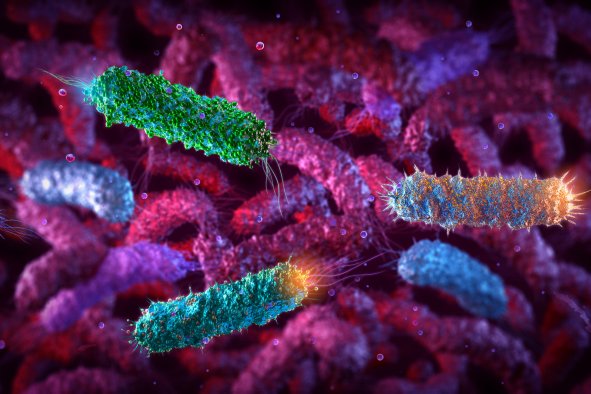A bizarre bacteria has been discovered with an ability previously thought impossible for its kind.
This organism, named Candidatus Uabimicrobium helgolandensis, is a single-celled organism that can do things that bacteria were thought to not be able to do, including "eating" other cells like a microscopic Pac-Man, according to a new paper in the journal mBio.
This strange discovery could shine a light on how some of our earliest single-celled ancestors formed billions of years ago.
"Enrichment of this strain indicates that there might be 'impossible' microbes out there, missed by metagenomic analyses," the researchers wrote in the paper.
Living organisms are made up of two kinds of cells—prokaryotes and eukaryotes. Prokaryotes are single-celled organisms that lack a nucleus and other membrane-bound organelles within the cell, and include all bacteria, while eukaryotes are organisms whose cells have a true nucleus enclosed by a nuclear membrane. Plants, animals, and fungi are all composed of eukaryotic cells.
It has long been hypothesized that the mitochondria in eukaryote cells—which are the classic "powerhouse" that provides us with energy—may have originated from ancient bacteria cells that entered another ancient prokaryote. However, it was thought that it was impossible for prokaryote cells to engulf one another.
"The idea of a 'fusion' of two different prokaryotes into one eukaryote seems incomprehensible to me from a cell biology perspective," Christian Jogler, a microbiologist at the University of Jena in Germany, said in a statement. "No one has ever observed anything like this before and such a hybrid would probably not be viable due to the different membrane structures and molecular machineries."
"By sequencing the genome of Uabimicrobium helgolandensis, we were also able to develop new hypotheses on the molecular mechanism of the absorption of prey bacteria," Jogler said.
Bacteria in the group Planctomycetota may be the missing link to this theory, however. These are bacteria that are able to behave unlike any other bacteria, being able to "walk" over each other or, in the case of a species named Candidatus Uabimicrobium amorphum, engulf other bacterial cells.
"Recently discovered strains again added novel and stunning aspects to the planctomycetal cell biology—shapeshifting by members of the Saltatorellus clade to an extent that is unprecedented in any other bacterial phylum, and phagocytosis-like cell engulfment in the bacterium Candidatus Uabimicrobium amorphum," the researchers wrote in the paper.
These discoveries give huge credence to the engulfment theory of how eukaryotic cells were born. To further investigate this ability in bacteria, the researchers hunted for other species with these unique abilities.
In this new paper, researchers describe another species of bacteria capable of engulfment: Ca. Uabimicrobium helgolandensis.
"We isolated a second 'bacterium of prey' from the harbor of Heligoland Island (North Sea, Germany)," the researchers wrote. "Our isolate shares key features with Ca. U. amorphum: phagocytosis-like cell engulfment, surface-dependent motility, and the same novel mode of cell division. Being related to Ca. U. amorphum within genus thresholds, we propose the name 'Ca. Uabimicrobium helgolandensis' for this strain."
This discovery implies that there might be more bacteria out there with strange abilities, which could help researchers better understand how eukaryotic cells first evolved.
"Candidatus Uabimicrobium helgolandensis HlEnr_7 adds to the explored bacterial biodiversity with its phagocytosis-like uptake of prey bacteria," the researchers wrote. "Such organisms have the potential to challenge our understanding of nature. For example, the origin of eukaryotes remains enigmatic, with a contentious debate surrounding both the mitochondrial host entity and the moment of uptake."
"The phagocytosis-like abilities of planctomycetal bacteria might influence the debate, demonstrating that prey engulfment is possible in a prokaryotic cellular framework," they wrote.
Do you have a tip on a science story that Newsweek should be covering? Do you have a question about bacteria? Let us know via science@newsweek.com.
References
Wurzbacher, C. E., Hammer, J., Haufschild, T., Wiegand, S., Kallscheuer, N., & Jogler, C. (2024) "Candidatus Uabimicrobium helgolandensis"—a planctomycetal bacterium with phagocytosis-like prey cell engulfment, surface-dependent motility, and cell division. mBio. https://doi.org/10.1128/mbio.02044-24
Disclaimer: The copyright of this article belongs to the original author. Reposting this article is solely for the purpose of information dissemination and does not constitute any investment advice. If there is any infringement, please contact us immediately. We will make corrections or deletions as necessary. Thank you.



